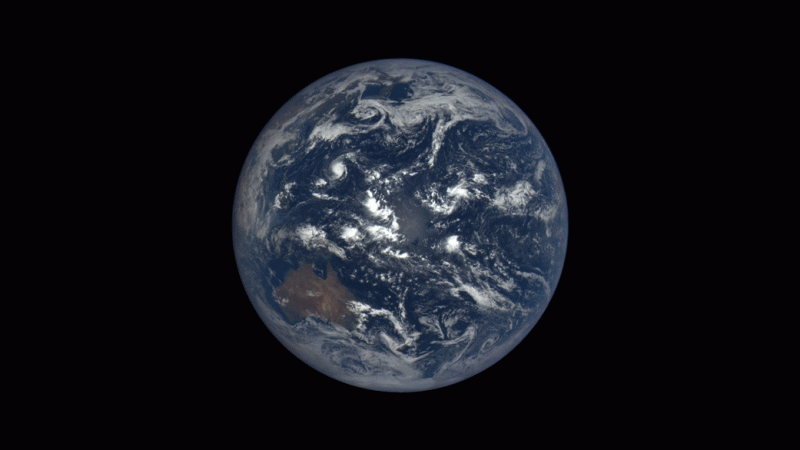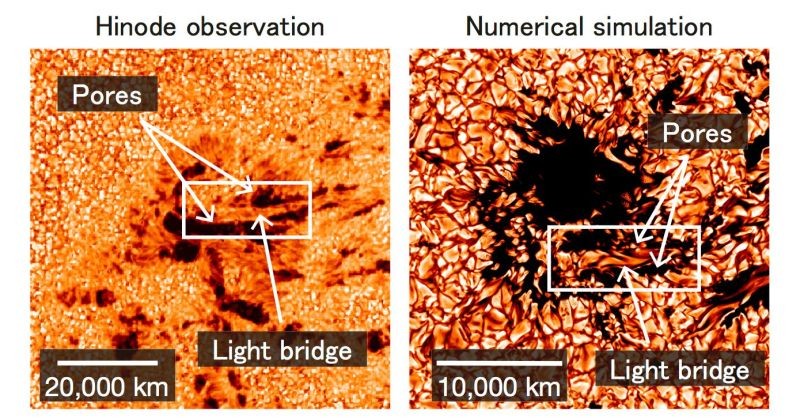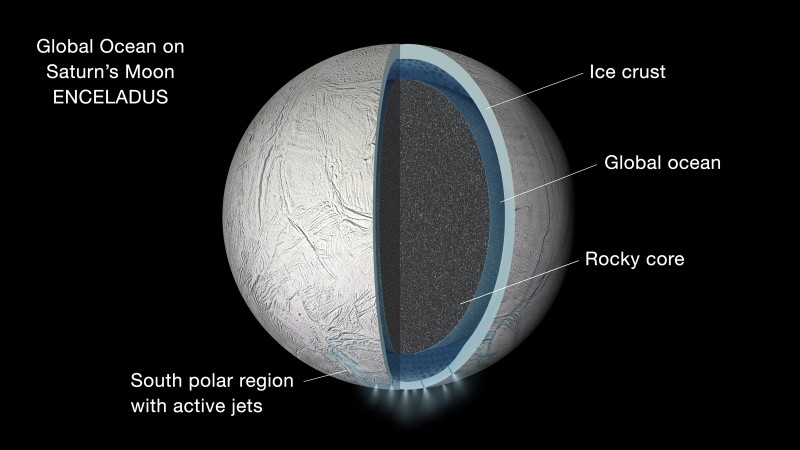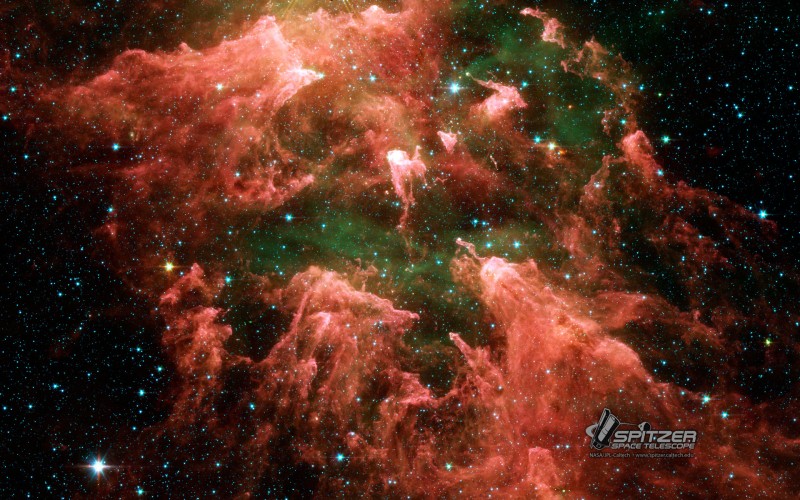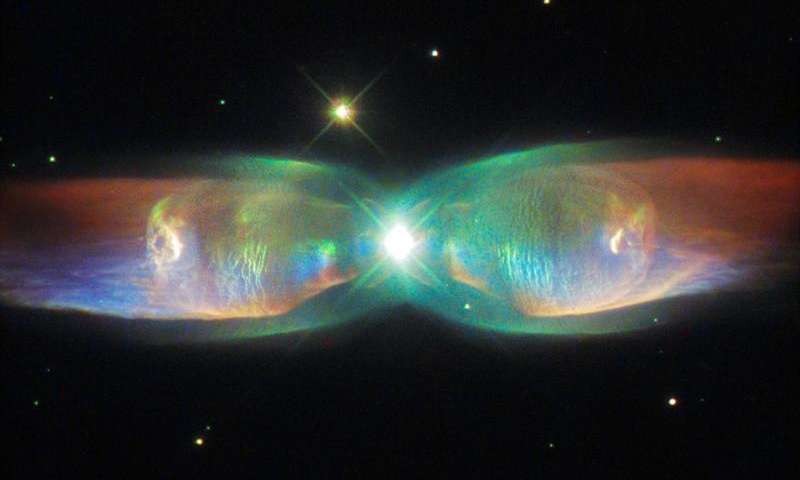Blog
Two Stars Heading for Catastrophe
Thursday, October 22nd 2015 11:17 PM
This artist’s impression shows VFTS 352 — the hottest and most massive double star system to date where the two components are in contact and sharing material. The two stars in this extreme system lie about 160,000 light-years from Earth in the Large Magellanic Cloud. This intriguing system could be heading for a dramatic end, either with the formation of a single giant star or as a future binary black hole.
ESO/L. Calçada
Using ESO’s Very Large Telescope (VLT), an international team of astronomers has found the hottest and most massive double star with components so close that they touch each other. The two stars in the extreme system VFTS 352 could be heading for a dramatic end, during which the two stars either coalesce to create a single giant star or form a binary black hole. The double star system VFTS 352 is located about 160,000 light-years away in the Tarantula Nebula. This remarkable region is the most active nursery of new st...
Read More
Read More
Daily Views of Earth Available on New NASA Website
Tuesday, October 20th 2015 07:15 PM
Earth rotates through an entire day as captured in this animation of 22 still images taken on Sept. 17, 2015 by NASA’s Earth Polychromatic Imaging Camera (EPIC) camera on the Deep Space Climate Observatory (DSCOVR) spacecraft.
Credits: NASA
NASA launched a new website Monday so the world can see images of the full, sunlit side of the Earth every day. The images are taken by a NASA camera one million miles away on the Deep Space Climate Observatory (DSCOVR), a partnership between NASA, the National Oceanic and Atmospheric Administration (NOAA) and the U.S. Air Force.
Once a day NASA will post at least a dozen new color images of Earth acquired from 12 to 36 hours earlier by NASA’s Earth Polychromatic Imaging Camera (EPIC). Each daily sequence of images will show the Earth as it rotates, thus revealing the whole globe over the course of a day. The new website also features an archive of EPIC images searchable by date and continent.
The primar...
Read More
Read More
Mechanism of Explosions and Plasma Jets Associated with Sunspot Formation Revealed
Tuesday, October 6th 2015 11:13 PM
Sunspots are planet-sized conglomerates of bundles of intense magnetic field lines on the surface of the Sun. They are known to cause explosions (solar flares) which can directly impact our technological infrastructure. What astrophysical mechanisms are responsible for the formation of sunspots and how do they drive explosive events are important questions in our quest to understand the Sun's activity and its magnetic effect on Earth. To tackle these questions, an international research team led by Shin Toriumi (Specially Appointed Assistant Professor at the National Astronomical Observatory of Japan) analyzed observations of sunspots as they formed taken by Hinode, the Solar Dynamics Observatory (SDO) and the Interface Region Imaging Spectrograph (IRIS) satellites.
The team modeled the observations using state-of-the-art numerical simulations performed on the Pleiades supercomputer at the NASA Ames Research Center. The study reveals how during the course of sunspot formation the te...
Read More
Read More
NASA Selects Investigations for Future Key Planetary Mission
Friday, October 2nd 2015 12:49 AM
Artist's concept of the Venus Emissivity, Radio Science, InSAR, Topography, and Spectroscopy (Veritas) spacecraft, a proposed mission for NASA's Discovery program. Image credit: NASA/JPL-Caltech
NASA has selected five science investigations for refinement during the next year as a first step in choosing one or two missions for flight opportunities as early as 2020. Three of those chosen have ties to NASA's Jet Propulsion Laboratory in Pasadena, California. The submitted proposals would study Venus, near-Earth objects and a variety of asteroids.
Each investigation team will receive $3 million to conduct concept design studies and analyses. After a detailed review and evaluation of the concept studies, NASA will make the final selections by September 2016 for continued development leading up to launch. Any selected mission will cost approximately $500 million, not including launch vehicle funding or the cost of post-launch operations.
"The selected investigat...
Read More
Read More
Get Ready for Upcoming Total Lunar Eclipse
Friday, September 18th 2015 05:23 AM
On the night of September 27–28, the full Moon will plunge completely through Earth's shadow for the last time until January 2018.
This map shows locations from which this month's total lunar eclipse is visible. The timing favors the Americas — especially the eastern parts — and western Europe and Africa.
If your skies are clear after the Sun sets on Sunday, September 27th, be sure to head outside to see the total lunar eclipse that happens that night. This will mark the end of a "tetrad" of four total lunar eclipses spaced a half year apart that began back in early 2014. But, perhaps more importantly, it's the last one visible anywhere until 2018.
During the upcoming total lunar eclipse, the Moon will take about 3.3 hours to cross Earth's umbra. -
Observers in the eastern half of North America can watch every stage of the eclipse, from beginning to end of the partial phases (31⁄3 hours...
Read More
Read More
Cassini Finds Global Ocean in Saturn's Moon Enceladus
Wednesday, September 16th 2015 07:45 AM
Illustration of the interior of Saturn's moon Enceladus showing a global liquid water ocean between its rocky core and icy crust. Thickness of layers shown here is not to scale. Image credit: NASA/JPL-Caltech
A global ocean lies beneath the icy crust of Saturn's geologically active moon Enceladus, according to new research using data from NASA's Cassini mission.
Researchers found the magnitude of the moon's very slight wobble, as it orbits Saturn, can only be accounted for if its outer ice shell is not frozen solid to its interior, meaning a global ocean must be present.
The finding implies the fine spray of water vapor, icy particles and simple organic molecules Cassini has observed coming from fractures near the moon's south pole is being fed by this vast liquid water reservoir. The research is presented in a paper published online this week in the journal Icarus.
Previous analysis of Cassini data suggested the presence of a lens-shaped body of water, or...
Read More
Read More
Ceres' Bright Spot In New Detail
Thursday, September 10th 2015 03:33 AM
This image, made using images taken by NASA's Dawn spacecraft, shows Occator Crater on Ceres, home to a collection of intriguing bright spots.
NASA/JPL-Caltech/UCLA/MPS/DLR/IDA
The brightest spots on the dwarf planet Ceres gleam with mystery in new views delivered by NASA's Dawn spacecraft. These closest-yet views of Occator Crater, with a resolution of 450 feet (140 meters) per pixel, give scientists a deeper perspective on these very unusual features. The new up-close view of Occator Crater from Dawn's current vantage point reveals better-defined shapes of the brightest central spot and features on the crater floor. Because these spots are so much brighter than the rest of Ceres' surface, the Dawn team combined two different images into a single composite view — one properly exposed for the bright spots and one for the surrounding surface. Dawn scientists note the rim of Occator Crater is almost vertical in some places, where it rises ste...
Read More
Read More
Dying Stars Suffer 'Irregular Heartbeats'
Thursday, August 27th 2015 06:08 AM
This is the "South Pillar" region of the star-forming region called the Carina Nebula. Like cracking open a watermelon and finding its seeds, the infrared telescope "busted open" this murky cloud to reveal star embryos tucked inside finger-like pillars of thick dust. Credit: NASA
Some dying stars suffer from 'irregular heartbeats', research led by astronomers at the University of Warwick has discovered.
The research confirms rapid brightening events in otherwise normal pulsating white dwarfs, which are stars in the final stage of their life cycles.
In addition to the regular rhythm from pulsations they expected on the white dwarf PG1149+057, which cause the star to get a few percent brighter and fainter every few minutes, the researchers also observed something completely unexpected every few days: arrhythmic, massive outbursts, which broke the star's regular pulse and significantly heated up its surface for many hours.
The discovery was made pos...
Read More
Read More
New Hubble image of the Twin Jet Nebula
Thursday, August 27th 2015 05:16 AM
The Twin Jet Nebula, or PN M2-9, is a striking example of a bipolar planetary nebula. Bipolar planetary nebulae are formed when the central object is not a single star, but a binary system, Studies have shown that the nebula's size increases with time, and measurements of this rate of increase suggest that the stellar outburst that formed the lobes occurred just 1200 years ago. Credit: ESA/Hubble & NASA Acknowledgement: Judy Schmidt
The shimmering colours visible in this NASA/ESA Hubble Space Telescope image show off the remarkable complexity of the Twin Jet Nebula. The new image highlights the nebula's shells and its knots of expanding gas in striking detail. Two iridescent lobes of material stretch outwards from a central star system. Within these lobes two huge jets of gas are streaming from the star system at speeds in excess of one million kilometres per hour.
The cosmic butterfly pictured in this NASA/ESA Hubble Space Telescope image go...
Read More
Read More
NASA's LADEE Spacecraft Finds Neon In Lunar Atmosphere
Wednesday, August 19th 2015 07:34 AM
"The presence of neon in the exosphere of the moon has been a subject of speculation since the Apollo missions, but no credible detections were made," said Mehdi Benna of NASA's Goddard Space Flight Center in Greenbelt, Maryland and the University of Maryland, Baltimore County. "We were very pleased to not only finally confirm its presence, but to show that it is relatively abundant." Benna is lead author of a paper describing observations from LADEE's Neutral Mass Spectrometer (NMS) instrument published May 28 in Geophysical Research Letters.
Artist’s concept of NASA's Lunar Atmosphere and Dust Environment Explorer (LADEE) spacecraft in orbit above the moon. Credits: NASA Ames / Dana Berry
There's not enough neon to make the moon visibly glow because the moon's atmosphere is extremely tenuous, about 100 trillion times less dense than Earth's atmosphere at sea level. A dense atmosphere like Earth's is relatively rare in our solar system because an object has to be...
Read More
Read More

